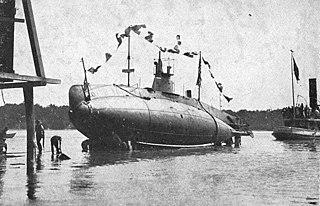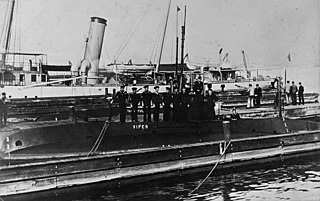
USS Adder, later renamed A-2, was one of seven Plunger-class submarines built for the United States Navy (USN) in the first decade of the 20th century.

USS Moccasin (SS-5) was one of seven Plunger-class submarines built for the United States Navy (USN) in the first decade of the 20th century.

HMS B1 was the lead boat of the B-class submarines built for the Royal Navy in the first decade of the 20th century. The boat survived the First World War and was sold for scrap in 1921.

USS N-2 (SS-54) was a N-class coastal defense submarine built for the United States Navy during World War I.

USS C-1 (SS-9) was the lead ship of her class of submarines built for the United States Navy in the first decade of the 20th century.

USS C-2 (SS-13) was one of five C-class submarines built for the United States Navy in the first decade of the 20th century.

USS C-4 (SS-15) one of five C-class submarines built for the United States Navy in the first decade of the 20th century.

USS C-3 (SS-14) was one of five C-class submarines built for the United States Navy in the first decade of the 20th century.

USS B-1 (SS-10) was the lead ship of her class of submarines built for the United States Navy in the first decade of the 20th century.

USS B-2 (SS-11) was one of three B-class submarines built for the United States Navy in the first decade of the 20th century.

The Rainbow-class submarine or R class was a quartet of patrol submarines built for the Royal Navy in the early 1930s.
HMS B2 was one of 11 B-class submarines built for the Royal Navy in the first decade of the 20th century.
HMS B3 was one of 11 B-class submarines built for the Royal Navy in the first decade of the 20th century. The boat survived the First World War and was sold for scrap in 1919.

HMS B4 was one of 11 B-class submarines built for the Royal Navy in the first decade of the 20th century. The boat survived the First World War and was sold for scrap in 1919.

HMS B5 was one of 11 B-class submarines built for the Royal Navy in the first decade of the 20th century. She survived World War I and was sold for scrap in 1921.

HMS B6 was one of 11 B-class submarines built for the Royal Navy in the first decade of the 20th century. The boat survived the First World War and was sold for scrap in 1921.

HMS B7 was one of 11 B-class submarines built for the Royal Navy in the first decade of the 20th century. Completed in 1906, she was initially assigned to the Home Fleet, before the boat was transferred to the Mediterranean six years later. After the First World War began in 1914, B7 played a minor role in the Dardanelles Campaign. The boat was transferred to the Adriatic Sea in 1916 to support Italian forces against the Austro-Hungarian Navy. She was converted into a patrol boat in 1917 and was sold for scrap in 1919.

HMS B8 was one of 11 B-class submarines built for the Royal Navy in the first decade of the 20th century. Completed in 1906, she was initially assigned to the Home Fleet, before the boat was transferred to the Mediterranean six years later. After the First World War began in 1914, B8 played a minor role in the Dardanelles Campaign. The boat was transferred to the Adriatic Sea in 1916 to support Italian forces against the Austro-Hungarian Navy. She was converted into a patrol boat in 1917 and was sold for scrap in 1919.

HMS B9 was one of 11 B-class submarines built for the Royal Navy in the first decade of the 20th century. Completed in 1906, she was initially assigned to the Home Fleet, before the boat was transferred to the Mediterranean six years later. After the First World War began in 1914, B9 played a minor role in the Dardanelles Campaign. The boat was transferred to the Adriatic Sea in 1916 to support Italian forces against the Austro-Hungarian Navy. She was converted into a patrol boat in 1917 and was sold for scrap in 1919.

HMS B10 was one of eleven B-class submarines built for the Royal Navy in the first decade of the 20th century. Completed in 1906, she was initially assigned to the Home Fleet, before the boat was transferred to the Mediterranean six years later. After the First World War began in 1914, B10 played a minor role in the Dardanelles Campaign. The boat was transferred to the Adriatic Sea in 1916 to support Italian forces against the Austro-Hungarian Navy. She was anchored in Venice when it was bombed by Austro-Hungarian aircraft on 9 August; B10 was sunk by one of their bombs and became the first submarine to be sunk by an aircraft in history. Salvaged by the Italians, she caught fire while under repair and became a constructive total loss. Her hulk was subsequently sold for scrap.
















